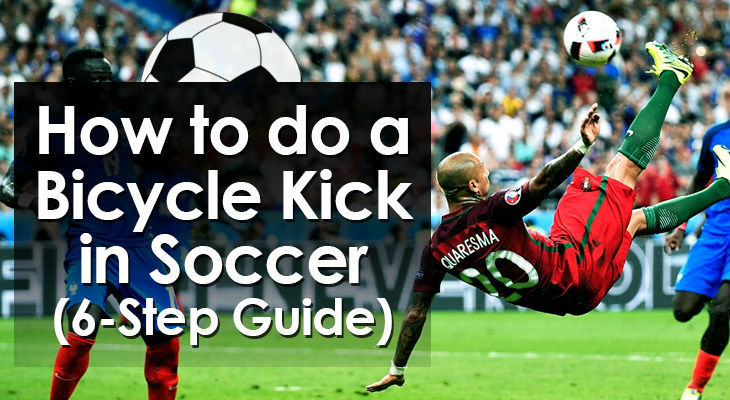How to Do a Bicycle Kick in Soccer (6-Step Guide)
Also known as an overhead or scissor kick, the bicycle kick is one of the most audacious skills a player can attempt during a match.
It involves a player hurling themselves backwards, twisting athletically with one leg pointed towards the sky, and then hoping to strike the ball ferociously through the net.
As you can tell, it’s not an easy move to pull off.
This is clear by how rare it is for players to actually pull off a bicycle kick during play.
One of the main reasons why they don’t occur often is because opportunities to pull off this outrageous piece of skill don’t pop up too often.
And when they do, a player needs to instinctively attempt the bicycle kick without a moment's thought in order to connect with the ball in a short amount of time.
All too often, the attempt goes poorly and the player ends up in a sad and sorry heap on the ground, ego and body slightly bruised.
To make sure you’re one of the few who know how to do a bicycle kick during a match, read these 6 how-to steps...
When to Attempt a Bicycle Kick
Before we get started, let’s talk about when players could use a bicycle kick…
As we’ve already discussed, times when it’s appropriate to use rarely occur which is why it’s so special to watch when a player does shoot an overhead kick into the back of the net.
There are three main scenarios where a bicycle kick opportunity can occur:
1. When a cross, free kick, or high ball ends up in the opposition box and the attacker determines that it’s an opportune moment to attempt a scissor kick.
2. When you’re defending and want to clear the ball from your penalty box.
3. When you have your back to goal and flick the ball up to do a bicycle kick, surprising the opposition’s goalkeeper and defenders.
How to do a Bicycle Kick in 6 Simple Steps:
Step #1 - Turn Your Back Towards Goal
To start with, make sure your back is turned towards the direction you want the ball to go.
When attacking, turn your back towards the exact area of the net you want the ball fly past the goalkeeper and end up in.
When defending, that could be anywhere away from goal.
Step #2 - Push Off the Ground With Your Striking Foot
To get the elevation and thrust you need, push hard off the ground with the foot you want to hit the soccer ball with.
This can vary depending on the situation on the pitch, but jumping off the kicking foot is the general rule you want to keep in mind.
After pushing off, thrust the knee of your opposite leg as high as possible as this will give you the balance, power, and momentum to then raise your striking foot high above your head.
Step #3 - Lean Your Head and Shoulders Backwards
After having completed the first two steps, throw your weight backwards to add to the momentum which will allow you to bring your striking leg upwards.
But don’t throw your body backwards too quickly as this may end up in you losing control or accuracy of the shot.
While doing this, make sure you stay focused on the ball and your technique as this will increase your chances of a successful bicycle kick.
Step #4 - Lift Your Striking Leg as High as Possible
As your momentum takes you backwards, move your legs in a bicycle motion.
This means you’ll bring your non-striking foot down while thrusting your striking foot up high towards the ball in a sharp, swift movement.
As you’ve probably guessed, the motion of the legs in the air is where this move gets its name.
Step #5 - Kick the Ball
Now that your body is in position with your back towards the target and striking leg stretched high above you, it’s time to strike the ball.
The goal is to kick with the top of your foot and send the ball blasting past the keeper with venomous power.
Aim to make contact on the higher part of the ball to strike downwards, or, depending on the angle you have, in the centre of the ball to make it arrow straight at goal.
You don't want to hit the bottom of it as that will send the ball rocketing into the sky.
Step #6: Land Safely
Coming back to ground, there are a few different ways to land without too much of a thud and without knocking the wind out of yourself.
Option 1 - Use your arms to limit the impact so that you don’t land too heavily on your back.
Option 2 - Twist yourself in the air as you’re falling to land more on your side instead of directly onto your back.
If possible, practice this move before attempting to use it during a match so that you can get used to falling back to the ground safely.

7 Important Bicycle Kick Tips to Remember
Tip #1 - Practice on a Soft Surface
When you’re first starting to work on the bicycle kick, I highly recommend practicing on a soft surface so that you don’t end up hurting yourself.
Grass and most astro-turfs are perfect for this.
Never practice this move indoors. Leave that to the futsal pros!
Tip #2: Learn How to Fall
A safe fall back to Earth is just as important as striking the ball and making the shot.
Practice until you feel comfortable throwing yourself daringly at the ball, safe in your knowledge of how to come down without hurting yourself.
This will give you the confidence to focus completely on putting the ball in the back of the net when you execute the bicycle kick during a game instead of worrying about an injury.
Tip #3 - Practice With a Friend
Practicing the bicycle kick with a friend can be great fun from time to time.
For best results, get them to throw the ball to your from different directions and different angles as you never know how the ball is going to come to you during games.
This will make your practicing more authentic and it’s much better than throwing the ball up to yourself every time.
But, if you are by yourself, incorporate the bicycle kick into your juggling.
Tip #4 - Is There a Better Option?
As fun as the bicycle kick is, you should always consider if there’s a better alternative first before resorting to such a difficult move.
The last thing you want to do is let down your team by showboating.
If there’s an easier option, take it.
But of course, if the only option you have is the bicycle kick, give it a go!
Tip #5 - Timing Is Key
You can get free in the box, position yourself perfectly, and know exactly how to do a bicycle kick perfectly, but that all counts for nothing if your timing is off.
Timing is everything with this unique skill and is one of the main reasons why it’s so hard to do.
You must judge the speed and trajectory of the cross or free kick perfectly and then time your jump exactly right to have even the slightest chance of being successful.
Great connection does come down to some luck, but by practicing and working on your timing you can increase your chances of a clean strike on the ball.
Tip #6 - Put in All the Power You’ve Got
Even seasoned pros struggle to direct their overhead kicks so most players simply try to get as much power on the strike as possible.
It’s incredibly difficult to aim for a specific part of the goal.
Which is why the bicycle kick mainly relies on speed and an element of surprise to get the ball past the keeper.
Since it’s such an unusual strike, a well-timed shot can be very effective as the keeper will be caught off guard due to the unpredictability of the shot attempt.
Conclusion
A successful bicycle kick where the ball arrows into the back of the net will live on in the spectator’s memories because it’s such a rare event.
Many things must go in the attacker’s favour for it to happen:
• The ball being perfectly set up in the air.
• The player having the athleticism and skill to execute.
• Perfect timing on contact.
And much more.
With enough practice, hopefully the opportunity for a bicycle kick will happen for you too!

